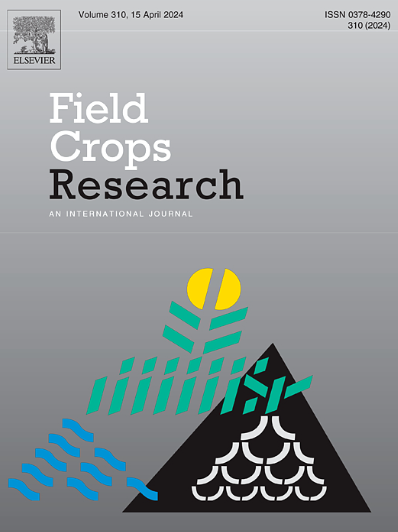1984 - 2014年阿根廷中部丰水干旱胁迫条件下成熟ⅳ组大豆品种遗传进展
IF 5.6
1区 农林科学
Q1 AGRONOMY
引用次数: 0
摘要
传统上,阿根廷中部的大豆遗传增益是在高产条件下估计的。到目前为止,在水梯度上的繁殖努力的贡献是未知的。目的评价不同水分供应情景下大豆产量遗传增益,以(i)研究育种对大豆产量潜力和抗旱性的贡献,(ii)评估所观察到的产量增加背后的生理机制。方法选用1984 ~ 2014年投放市场的6个成熟期为IV组的品种。这些品种在水分充足和干旱胁迫条件下进行了评价。通过评估氮素捕获、分配和浓度来了解解释种子产量随时间变化的生理属性。结果平均而言,缺水条件下的产量比丰水条件下低61 %。丰水环境下的绝对产量遗传进展较高(丰水和胁迫条件下分别为31.6和12.8 kg ha−1年−1),但相对产量增益相似(1 %−1年−1)。绝对产量随时间的变化与较高的总氮捕获量相关(水分充足和胁迫条件下分别为2.1和0.5 kg N ha−1年−1)。从出苗期到成熟期的生物固氮被确定为这种差异氮吸收的驱动因素(在水分充足和缺水的环境中分别为1.4和0.5 kg N ha−1年−1)。营养阶段绝对生物固氮遗传进程的成比例增加解释了在水分充足条件下生长的新基因型较高的生物固氮(水分充足和胁迫条件下分别为0.5和0.03 kg N ha−1年−1)。结论:在有限的试验品种中,育种工作提供了更高的产量潜力,并具有一定程度的耐旱性。生物固氮修饰是丰水和干旱环境下绝对产量遗传增益差异的主要原因。营养阶段较高的BNF解释了本研究最新投放市场的品种具有较高的产量潜力。本研究通过评估不同水情景下的产量轨迹,补充了阿根廷中部的遗传增益估计。未来的研究应集中在与总氮吸收和生物固氮有关的过程的遗传决定因素上。本文章由计算机程序翻译,如有差异,请以英文原文为准。
Soybean genetic progress of maturity group IV cultivars under well-watered and drought stress conditions in central Argentina between 1984 and 2014
Context
Soybean genetic gain in central Argentina has traditionally been estimated under high-yielding conditions. To the present, the contribution of breeding efforts over a water gradient is not known.
Objective
To evaluate soybean yield genetic gain under contrasting water availability scenarios to (i) investigate breeding contributions to soybean yield potential and drought stress tolerance, and (ii) evaluate the physiological mechanisms behind the observed yield increases.
Methods
We used six cultivars belonging to maturity group IV, which were released into the market between 1984 and 2014. These cultivars were evaluated under well-watered and drought-stressed conditions. Nitrogen (N) capture, partitioning, and concentration were evaluated to understand the physiological attributes that explain seed yield changes over time.
Results
On average, the water-stressed condition yielded 61 % less compared to the well-watered. Absolute yield genetic progress was higher in the well-watered environment (31.6 and 12.8 kg ha−1 year−1 for the well-watered and stressed conditions, respectively), but relative yield gain was similar (1 % year−1). Absolute yield changes over time were correlated to higher total N capture (2.1 and 0.5 kg N ha−1 year−1 for the well-watered and stressed condition, respectively). Biological N fixation from emergence to maturity was identified as the driver of this differential N uptake (1.4 and 0.5 kg N ha−1 year−1 in the well-watered and water stressed environment, respectively). More than proportional increases in absolute biological N fixation genetic progress during vegetative stages explained the higher biological N fixation in newer genotypes grown under well-watered conditions (0.5 and 0.03 kg N ha−1 year−1, for the well-watered and stressed condition, respectively).
Conclusions
Within the limited set of tested varieties, breeding efforts delivered higher yield potential with some degree of drought stress tolerance. Biological N-fixation modifications are responsible for the absolute yield genetic gain differences in well-watered vs. drought environments. Higher BNF in vegetative stages explained the higher yield potential of the latest cultivars released to the market in this study.
Implications
This study complements genetic gain estimations in central Argentina by evaluating the yield trajectories under contrasting water scenarios. Future investigations should focus on the genetic determinants of the processes related to total N uptake and the biological N fixation.
求助全文
通过发布文献求助,成功后即可免费获取论文全文。
去求助
来源期刊

Field Crops Research
农林科学-农艺学
CiteScore
9.60
自引率
12.10%
发文量
307
审稿时长
46 days
期刊介绍:
Field Crops Research is an international journal publishing scientific articles on:
√ experimental and modelling research at field, farm and landscape levels
on temperate and tropical crops and cropping systems,
with a focus on crop ecology and physiology, agronomy, and plant genetics and breeding.
 求助内容:
求助内容: 应助结果提醒方式:
应助结果提醒方式:


